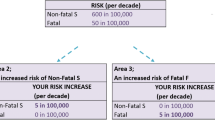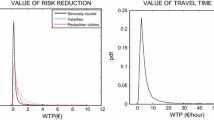Abstract
This article reports the results of two studies aimed at estimating preference-based values of safety in three contexts—namely rail, domestic fires and fires in public places—relative to the corresponding value for roads using “matching” (or “equivalence”) questions. In addition, both studies included a variety of questions intended to shed light on respondents' perceptions of risk and attitudes to safety in the various contexts. While the two studies were, to all intents and purposes, identical in the procedure that they employed, the essential difference between them was that the first study took place in late 1998, whereas the second study was carried out in early 2000 in the aftermath of a major rail accident at Ladbroke Grove near London's Paddington station which occurred in October 1999 and in which 29 passengers and 2 train drivers died. In addition, the second study sample was deliberately weighted to contain an above-average proportion of regular rail users. These studies demonstrated how certain factors which have been shown to affect people's perception of risk (see Slovic, P. (1992). In S. Krimsky and D. Golding (eds.), Social Theories of Risk, Westport, CT: Praeger, pp. 117–152) also affected our respondents' priorities over safety programs. The results also showed however, that the impact of these perceptions upon the trade-offs between preventing deaths in different hazard contexts was a good deal less pronounced than has been suggested by the value differentials that are currently implicit—and in some cases, explicit—in public policy making.
Similar content being viewed by others
References
Beattie, J., J. Covey, P. Dolan, L. Hopkins, M. Jones-Lee, G. Loomes, N. Pidgeon, A. Robinson, and A. Spencer. (1998). “On the Contingent Valuation of Safety and the Safety of Contingent Valuation: Part 1-Caveat Investigator,” Journal of Risk and Uncertainty 17(1), 5-25.
Beattie, J., T. Carthy, S. Chilton, J. Covey, P. Dolan, L. Hopkins, M. Jones-Lee, G. Loomes, N. Pidgeon, A. Robinson, and A. Spencer. (2000a). Valuation of Benefits of Health and Safety Control: Final Report. London: Health and Safety Executive.
Beattie, J., T. Carthy, S. Chilton, J. Covey, P. Dolan, L. Hopkins, M. Jones-Lee, G. Loomes, N. Pidgeon, A. Robinson, and A. Spencer. (2000b). Valuation of Benefits of Health and Safety Control: Technical Report. London: Health and Safety Executive.
Burton, A., S. Chilton, J. Covey, H. Gilbert, M. Jones-Lee, G. Loomes, N. Pidgeon, A. Robinson, A. Spencer, and J. Twist. (2000). Valuation of Benefits of Health and Safety Control: Follow-Up Study. London: Health and Safety Executive.
Carthy, T., S. Chilton, J. Covey, L. Hopkins, M. Jones-Lee, G. Loomes, N. Pidgeon, and A. Spencer. (1999). “On the Contingent Valuation of Safety and the Safety of Contingent Valuation: Part 2-The CV/SG 'Chained' Approach,” Journal of Risk and Uncertainty 17(3), 187-213.
Covey, J. (2001). “People's Preferences for Safety Control: Why do Baseline Risks Matter?” Risk Analysis 21(2), 331-340.
Cropper, M.L., S.K. Aydede, and P.R. Portney. (1994). “Preferences for Life-Saving Programs: How the Public Discounts Time and Age,” Journal of Risk and Uncertainty 8, 243-265.
Evans. (2000). “Fatal Train Accidents on Britain's Mainline Railways,” Journal of the Royal Statistical Society A 163, 99-119.
Jones-Lee, M.W. and G. Loomes. (1995). “Scale and Context Effects in the Valuation of Transport Safety,” Journal of Risk and Uncertainty 11, 183-203.
Kasperson, R.E. (1992). “The Social Amplification of Risk.” In S. Krimsky and D. Golding (eds.), Social Theories of Risk, Westport, CT: Praeger, pp. 153-178.
Kasperson, R.E., O. Renn, P. Slovic, H.S. Brown, J. Emel, R. Goble, J.X. Kasperson, and S. Ratick. (1988). “The Social Amplification of Risk: A Conceptual Framework,” Risk Analysis 8, 177-187.
McDaniels, T.L., M.S. Kamlet, and G.W. Fischer. (1992). “Risk Perception and the Value of Safety,” Risk Analysis 12, 495-503.
Mendeloff, J. and R.M. Kaplan. (1990). “Are Twenty-Fold Differences in 'Lifesaving' Costs Justified? A Psychometric Study of the Relative Value Placed on Preventing Deaths from Programs Addressing Different Hazards.” In L.A. Cox, Jr. and D.F. Ricci (eds.), New Risks, New York: Plenum Press.
Nord, E. (1992). “The Person-Trade-Off Approach to Valuing Health Care Programs,” Medical Decision Making 15(3), 201-208.
Pidgeon, N.F. (1999). “Social Amplification of Risk: Models, Mechanisms and Tools for Policy,” Risk, Decision and Policy 4(2), 145-159.
Railtrack. (2000). Railway Group Safety Plan 2000/01, London, Safety and Standards Directorate, Railtrack PLC.
Savage, I. (1993). “An Empirical Investigation into the Effect of Psychological Perceptions on the Willingness-to-Pay to Reduce Risk,” Journal of Risk and Uncertainty 6, 75-90.
Slovic, P. (1992). “Perceptions of Risk: Reflections on the Psychometric Paradigm.” In S. Krimsky and D. Golding (eds.), Social Theories of Risk, Westport, CT: Praeger, pp. 117-152.
Slovic, P., B. Fischhoff, and S. Lichtenstein. (1981). “Perceived Risk: Psychological Factors and Social Implications.” In F. Warner (ed.), The Assessment and Perception of Risk, Proceedings of the Royal Society, Vol. 376. London: The Royal Society, pp. 17-34.
Subramanian, U. and M. Cropper. (2000). “Public Choices Between Life Saving Programs. The Tradeoff Between Qualitative Factors and Lives Saved,” Journal of Risk and Uncertainty 21(1), 117-149.
Sunstein, C.R. (1997). “Bad Deaths,” Journal of Risk and Uncertainty 14, 259-282.
Thomas, K. (1981). “Comparative Risk Perception: How the Public Perceives the Risk and Benefits of Energy Systems.” In F. Warner (ed.), The Assessment and Perception of Risk, Proceedings of the Royal Society,Vol. 376. London: The Royal Society, pp. 35-50.
Viscusi, W.K. (1993). “The Value of Risks to Life and Health,” Journal of Economic Literature 31, 1912-1946.
Viscusi, W.K., W.A. Magat, and J. Huber. (1991). “Pricing Environmental Health Risks: Survey Assessments of Risk-Risk and Risk-Dollar Trade-Offs for Chronic Bronchitis,” Journal of Environmental Economics and Management 21, 32-51.
Author information
Authors and Affiliations
Corresponding author
Rights and permissions
About this article
Cite this article
Chilton, S., Covey, J., Hopkins, L. et al. Public Perceptions of Risk and Preference-Based Values of Safety. Journal of Risk and Uncertainty 25, 211–232 (2002). https://doi.org/10.1023/A:1020962104810
Issue Date:
DOI: https://doi.org/10.1023/A:1020962104810




